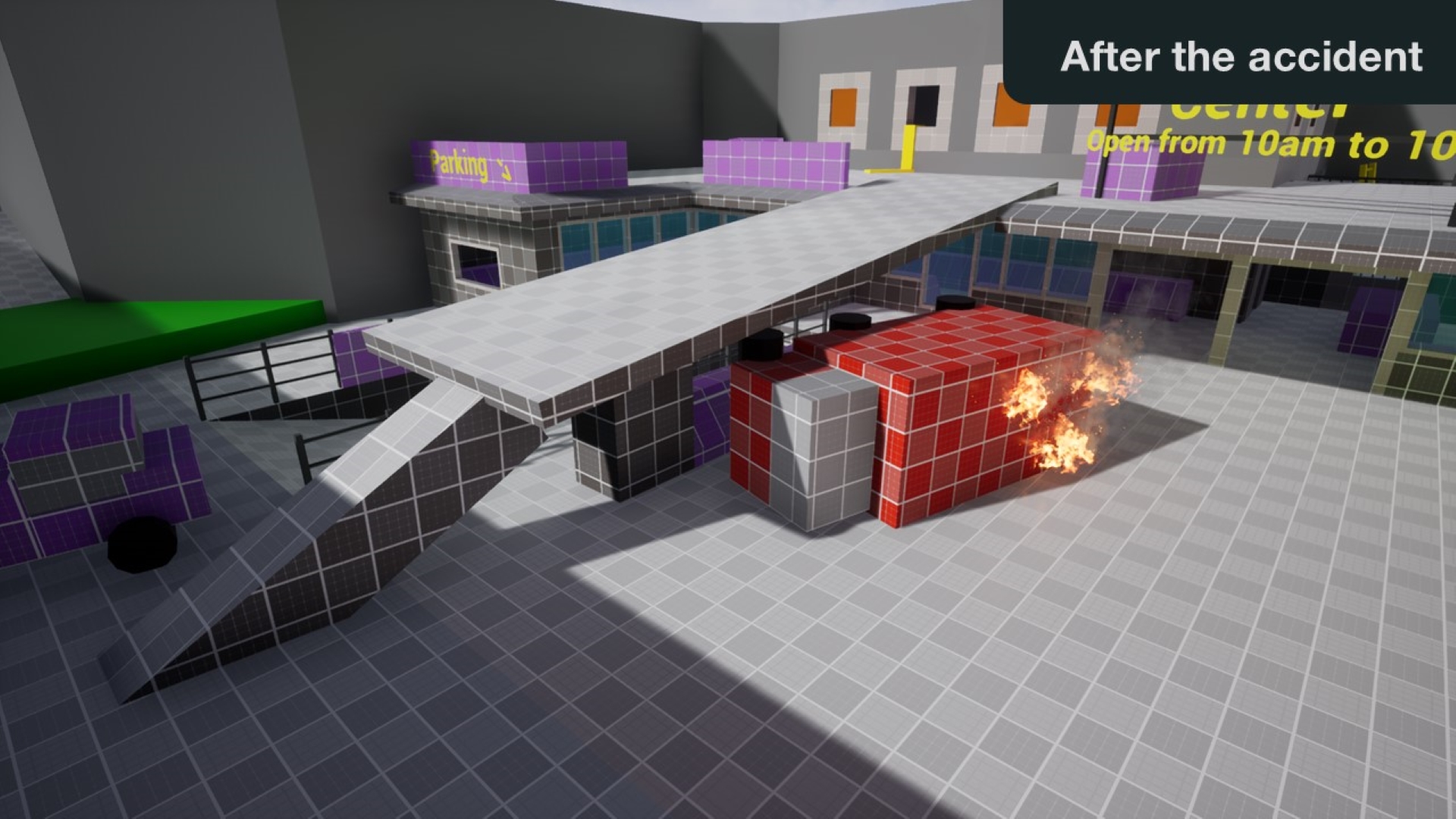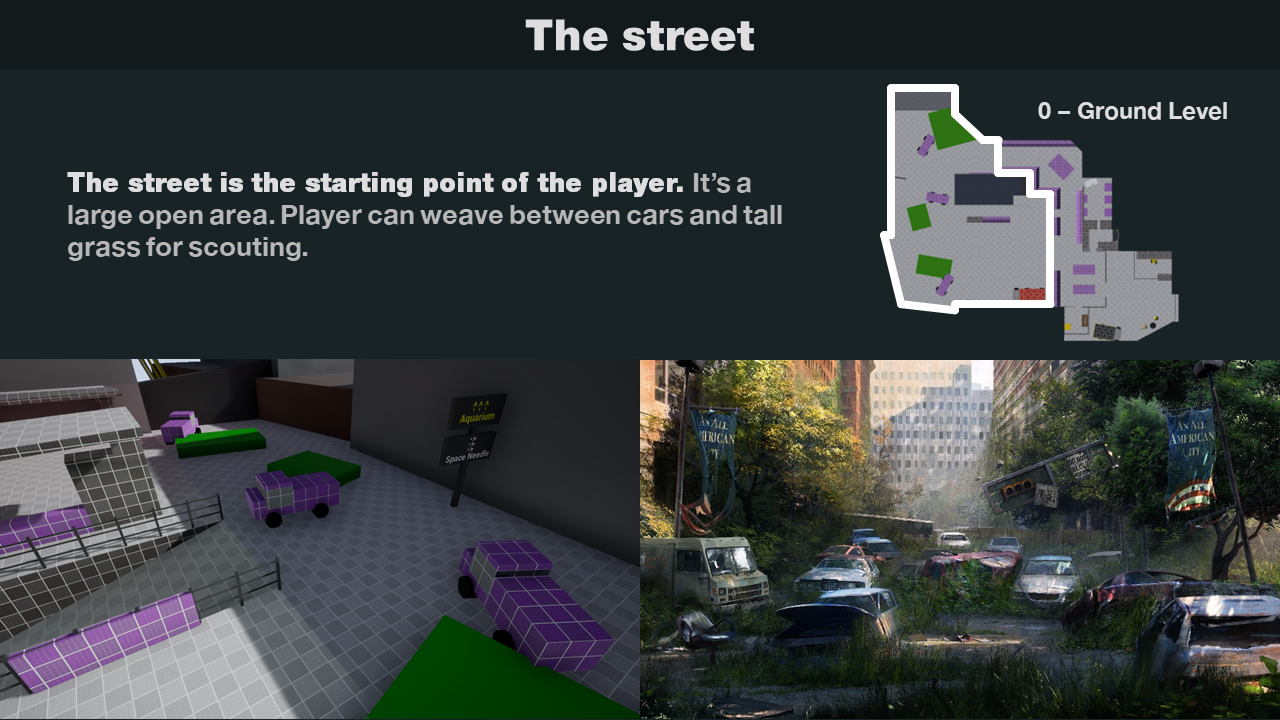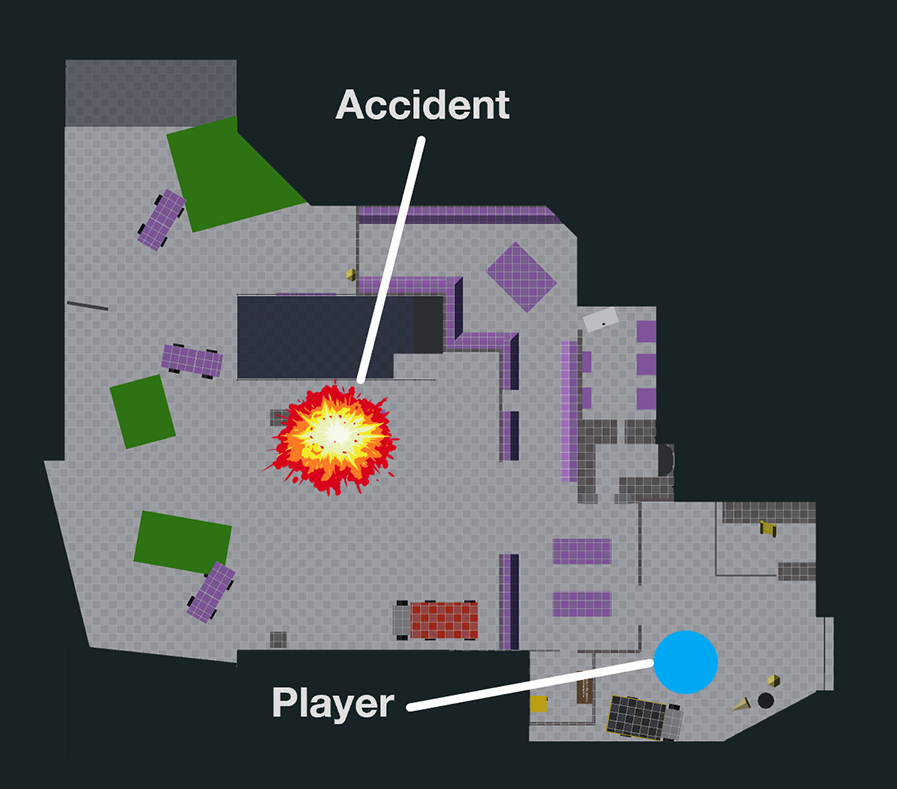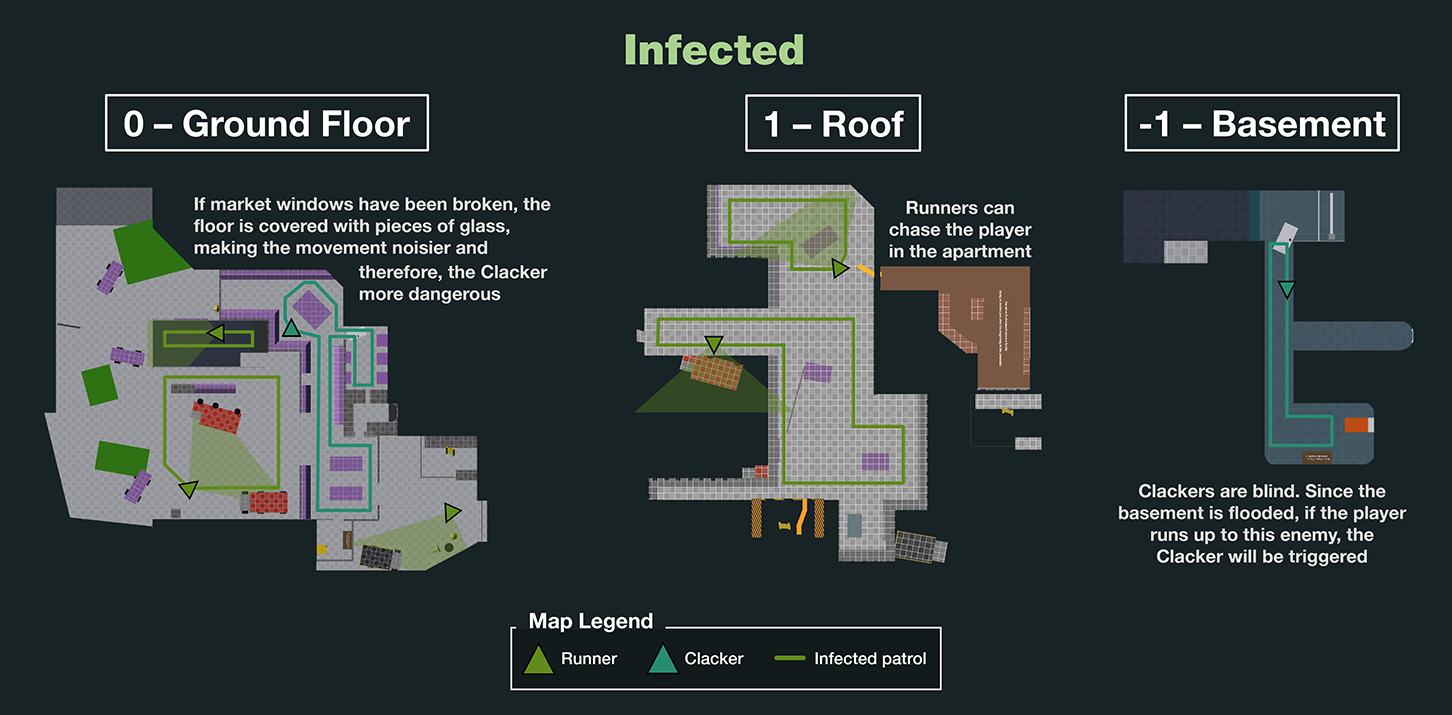Creation of a Last of Us Part II area:
«Public Market»
Project breakdown
• Solo project
• Four production days
• Created using Unreal Engine 4.27
• Set piece based on surprise and chaos
It's better to continue reading on this page
Level brief and intentions
For more narrative context and design direction.
Ellie is looking for Joel's killers and heads for the aquarium. After an intersection, the road is blocked, and the only way to continue her way is through the roofs. The problem is that to get to the rooftop, Ellie must pass through a market occupied by soldiers of the WLF, the paramilitary faction of the game.
Surprise and chaos
I wanted an innovative event for the series, one that would surprise the player. This is the truck crash, which splits the pathing in two: before the crash, it's a classic infiltration level, and after the crash, the area turns into a chaotic battlefield between soldiers and infected, forcing the player to improvise.
Verticality
The player must be able to navigate between different heights. This allows for improved combat areas and interesting lines of sight.
Exploration
Even though the level is small in surface area, I wanted it to be very dense, so that the player would be encouraged and enjoy exploring it. To achieve this, I integrated narrative storytelling, several atmospheres, and several possible paths for the player.
A layout on three floors
Allows alternative paths and makes combat more interesting.
Complete level breakdown
With references for each zone.
Complete level breakdown
With references for each zone.
Set piece: The truck crash
That's what the players will remember.
One of the things that stood out for me when playing The Last of Us Part II was its faction system, and how sometimes the game has several factions fighting at the same time. The player can take advantage of the surrounding chaos, or use their tools to provoke and take advantage of the fighting. I wanted to use this system in my level too, and add a little surprise and chaos to the area.
An example of factions fighting in the metro
Pitch
The player hears the WLF soldiers talking about a reinforcement truck that is supposed to arrive soon to prepare for the war against another faction of the game, the Seraphites.
When the player reaches the backyard, they hear a crash, then shots coming from the front of the market. It is the reinforcement truck that crashes in the yard.
A good reference for the truck crash would be the beginning of Resident Evil 2
The soldiers who were supposed to come as reinforcements, inside the truck, were infected and get out of the vehicle. The market turns into a battlefield between humans and the infected.
The fact that the player cannot see the accident and discovers it afterward by returning to the market or by climbing on the roof reinforces the intention of surprise.


The crash creates a new roof access
Set piece: The truck crash
That's what the players will remember.
One of the things that stood out for me when playing The Last of Us Part II was its faction system, and how sometimes the game has several factions fighting at the same time. The player can take advantage of the surrounding chaos, or use their tools to provoke and take advantage of the fighting. I wanted to use this system in my level too, and add a little surprise and chaos to the area.
An example of factions fighting in the metro
Pitch
The player hears the WLF soldiers talking about a reinforcement truck that is supposed to arrive soon to prepare for the war against another faction of the game, the Seraphites.
When the player reaches the backyard, they hear a crash, then shots coming from the front of the market. It is the reinforcement truck that crashes in the yard.
A good reference for the truck crash would be the beginning of Resident Evil 2
The soldiers who were supposed to come as reinforcements, inside the truck, were infected and get out of the vehicle. The market turns into a battlefield between humans and the infected.
The fact that the player cannot see the accident and discovers it afterward by returning to the market or by climbing on the roof reinforces the intention of surprise.


The crash creates a new roof access
Enemies in the area
With the paths they follow.
There is an element of randomness in AI-controlled faction battles, especially in the aiming of soldiers, or the path of infected. Therefore, after the truck accident, the winner between infected and WLF if the player does not intervene depends on how many soldiers the player killed before the accident, and as explained the random factor.
Randomness is not a problem for me here. It adds replayability and accentuates the intention of chaos.
The disposition of the enemies shown here depends on which side wins, and some of them will surely have died in battle. Furthermore, the positions shown are those before and after the accident for WLF soldiers, and only after the end of the battle for the infected.
Key points of view
Important for the player's understanding of the level.
Start-of-level viewpoint
From the first look, I wanted the exit to be as clear as possible. To achieve this, I used yellow, contrasting shapes, movement, the sun, and leading lines to guide the player's eyes.


First sight of the ladder
Since the ladder is the key object of the level my goal here was to draw attention to it and then to show how to access it. I used yellow, movement, leading lines, and color contrast.


Key points of view
Important for the player's understanding of the level.
Start-of-level viewpoint
From the first look, I wanted the exit to be as clear as possible. To achieve this, I used yellow, contrasting shapes, movement, the sun, and leading lines to guide the player's eyes.


First sight of the ladder
Since the ladder is the key object of the level my goal here was to draw attention to it and then to show how to access it. I used yellow, movement, leading lines, and color contrast.


Environmental storytelling
Stories and puzzles to encourage exploration.
One of the many things I like about The Last of Us Part II is the exploration for resources and environmental storytelling. That's why I've added it to my level, as a reward for players who like to explore.
The apartment
An apartment in disarray, it seems that people had to run away after the beginning of the pandemic. A note is left saying that the mother is not answering and that the father will try to migrate to Canada with their little girl.
The market safe
If the player is attentive, they can see a room inside the market barricaded from the inside, containing a safe. It can be accessed through the roof by breaking a window above the room.
A note is next to the safe, indicating that the code is the market opening time, 1010, found on the building sign on the roof.
The hunter hideout
In the basement, the player can find the belongings of a Hunter, a cannibal faction. Among his belongings, several notes are available for cannibal cooking recipes, and reports of city explorations. The camp appears to have been recently abandoned.
Environmental storytelling
Stories and puzzles to encourage exploration.
One of the many things I like about The Last of Us Part II is the exploration for resources and environmental storytelling. That's why I've added it to my level, as a reward for players who like to explore.
The apartment
An apartment in disarray, it seems that people had to run away after the beginning of the pandemic. A note is left saying that the mother is not answering and that the father will try to migrate to Canada with their little girl.
The market safe
If the player is attentive, they can see a room inside the market barricaded from the inside, containing a safe. It can be accessed through the roof by breaking a window above the room.
A note is next to the safe, indicating that the code is the market opening time, 1010, found on the building sign on the roof.
The hunter hideout
In the basement, the player can find the belongings of a Hunter, a cannibal faction. Among his belongings, several notes are available for cannibal cooking recipes, and reports of city explorations. The camp appears to have been recently abandoned.
Real life inspiration
To be coherent with the game city.
The Last of Us Part II takes place mainly in the city of Seattle, and Naughty Dog has made a real effort to ensure that the game's levels take place in real city buildings. That's why, on my scale and with the time I had, I decided to look for an interesting building to work from, and chose the Pike Place Market.
Level walkthough
To understand what a game session looks like.
Level walkthough
To understand what a game session looks like.
Reflections
Game wise
The game shines when it succeeds in making the player feel that they are the predator in the level, sneaking around corners, using their environment, and emerging from the tall grass to murder their enemies. This is even truer when playing as Ellie.
Designing a level for this game means trying to get the player into the character, giving them the right paths and opportunities to be the level's predator.
Design wise
I learned a lot designing around the AI faction fight, which is a subtle mechanic, to make it a unique level. It's subtle because you don't see it much, and it's not what people remember about the game. Not every game has as many sub-systems as The Last of Us Part 2, but seeking them out and designing around them is something I'll be reproducing in the future.
On another note, designing an area around a single building, and forcing myself to keep the whole thing relatively small for scope reasons with the time I had, was interesting. I'm glad I didn't make the level too big, but rather a small but dense area.
Project wise
I'm really happy with what I've managed to produce in such a short time. I'm proud of my concept, and I've learned a lot about scope and scale management. I'm also happy to have been able to tackle so many aspects of the level, with topography, enemies and storytelling. My biggest problem with this project is not having a working game to test it on.
I didn't have time to prototype a character and enemies in my four production days. Without testing, it's impossible to check that the battle areas are coherent, that the lines of sight allow for interesting confrontations, or just to be able to test the truck crash concept.
Reflections
Game wise
The game shines when it succeeds in making the player feel that they are the predator in the level, sneaking around corners, using their environment, and emerging from the tall grass to murder their enemies. This is even truer when playing as Ellie. Designing a level for this game means trying to get the player into the character, giving them the right paths and opportunities to be the level's predator.
Design wise
I learned a lot designing around the AI faction fight, which is a subtle mechanic, to make it a unique level. It's subtle because you don't see it much, and it's not what people remember about the game. Not every game has as many sub-systems as The Last of Us Part 2, but seeking them out and designing around them is something I'll be reproducing in the future. On another note, designing an area around a single building, and forcing myself to keep the whole thing relatively small for scope reasons with the time I had, was interesting. I'm glad I didn't make the level too big, but rather a small but dense area.
Project wise
I'm really happy with what I've managed to produce in such a short time. I'm proud of my concept, and I've learned a lot about scope and scale management. I'm also happy to have been able to tackle so many aspects of the level, with topography, enemies and storytelling. My biggest problem with this project is not having a working game to test it on. I didn't have time to prototype a character and enemies in my four production days. Without testing, it's impossible to check that the battle areas are coherent, that the lines of sight allow for interesting confrontations, or just to be able to test the truck crash concept.
Selected Works


































